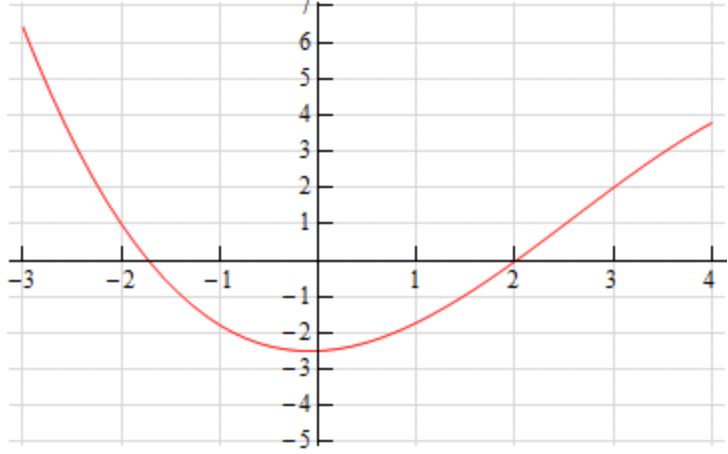d/dx (x^7)
7x^6
d/dx (x^2(2x^3 - 4x))
x^2(6x^2-4) + 2x(2x^3-4x) = 10x^4 - 12x^2
d/dx ((3x^2+9)/(x-5))
((x-5)(6x)-(3x^2+9)(1))/(x-5)^2 = (6x^2-30x-3x^2-9)/((x-5)^2) = (3x^2-30x-9)/((x-5)^2)
d/dx ((6x^2+7x)^4)
4(6x^2+7x)^3*(12x+7)
Fill in the blank:
"Let f(x) be a continuous function. The derivative of f(x) at a point x = a is the _______ of the line tangent to f(x) at x = a."
slope; the derivative of a function at a point is the slope of the line tangent to the function at that point!
d/dx (1/3 x^12 + 1/5x^20)
4x^11 + 4x^19
d/dx((3x^5-1)(x^3+5x^2+2))
(3x^5-1)(3x^2+10x) + (15x^4)(x^3+5x^2+2)
or expanded form:
9x^7 + 30x^6-3x^2-10x + 15x^7 + 75x^6 + 30x^4 = 24x^7 + 105x^6 + 30x^4 - 3x^2 - 10x
d/dx ((4sqrt(x))/(x^2-2))
((x^2-2)*2x^(-1/2) - 4x^(1/2)(2x))/(x^2-2)^2
=
(2x^(-1/2)(x^2-2) - 8x^(3/2))/((x^2-2)^2)
d/dx (e^(1-cosx))
e^(1-cosx)*(sinx)
Suppose you drop a tennis ball from the top of a building. Let f(x) represent the height (in ft) of the ball at time x (in seconds). What does f'(x) represent?
The derivative of a function can be thought of as the rate of change of that function (i.e. how fast the function is changing), so f'(x) represents the rate of change of height over time (i.e. how fast the height is changing over time).
d/dx (3/7x^14 - 3x^8-2x^-3)
6x^13 - 24x^7 + 6x^-4
or
6x^13 - 24x^7 + 6/x^4
d/dx (sinxcosx)
sinx(-sinx) + cosx(cosx) = cos^2x - sin^2x
d/dx ((6root(3)(x))/(4x^2+1))
((4x^2+1)(2x^(-2/3))-6x^(1/3)(8x))/(4x^2+1)^2
d/dx (ln(1-5x^3-x^7))
1/(1-5x^3-x^7)*(-15x^2-7x^6)
Use the graph of the function f(x) to estimate the value of f'(-2) and f'(3).

f'(-2) is approximately -4
f'(3) is approximately 2
d/dx (1/8x^(8/3) - 5/2 x^(12/25))
1/3 x^(5/3) - 6/5 x^(-13/25)
d/dx((5x^5-x^7)(20x^2+3x^-7))
(5x^5-x^7)(40x-21x^-8)+(25x^4-7x^6)(20x^2+3x^-7)
or expanded form:
200x^6 - 105x^-3 -40x^8 +21x^-1 + 500x^6 + 75x^-3 -140x^8 -21x^-1 = 700x^6 - 30x^-3 -180x^8
d/dx ((4sinx)/(2x+cosx))
((2x+cosx)(4cosx)-(4sinx)(2-sinx))/(2x+cosx)^2
d/dx x^2ln(x^5)
x^2(1/x^5*5x^4) + 2xln(x^5)
Determine where, if anywhere, the following function stops changing.
g(x) = x^3-2x^2+x-1
x = 1/3, x = 1
d/dx (1/x - 2/x^2 + 3/x^3 - 4/x^4 + 5/x^5)
-x^-2 + 4x^-3 -9x^-4+16x^-5 -25x^-6
d/dx ((arctanx)(lnx))
(arctanx)(1/x) + (1/(x^2+1))(lnx) = arctanx/x + lnx/(x^2+1)
d/dx((1-lnx)/(x^2-lnx))
((x^2-lnx)(-1/x)-(1-lnx)(2x-1/x))/(x^2-lnx)^2
d/dx (2sin(3x+tanx))
2cos(3x+tan(x))*(3+sec^2x)
Write the equation of the tangent line to the following function at the given point (using y = mx + b form).
f(x) = 5/x \text{ at } x = 1/2
y = 20-20x